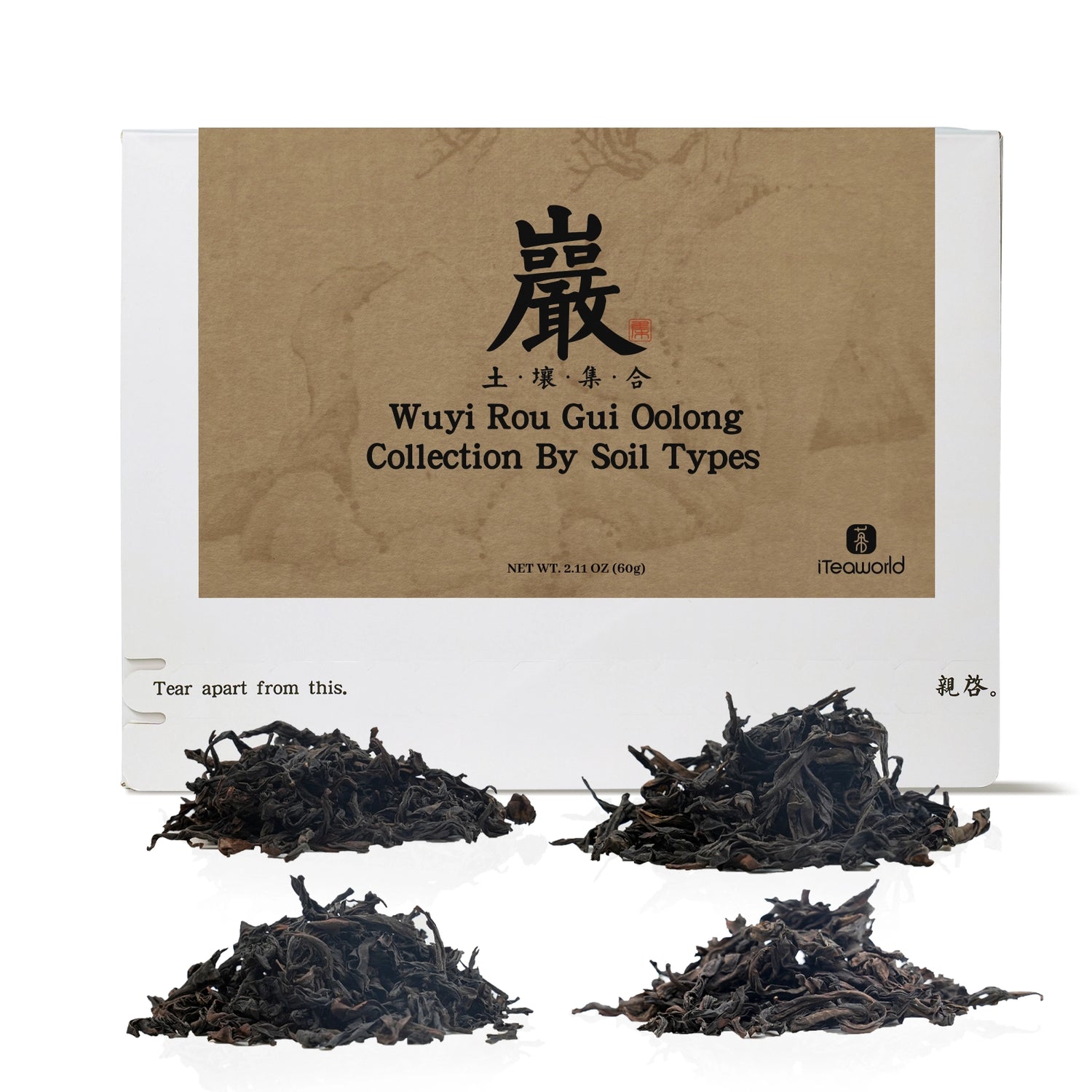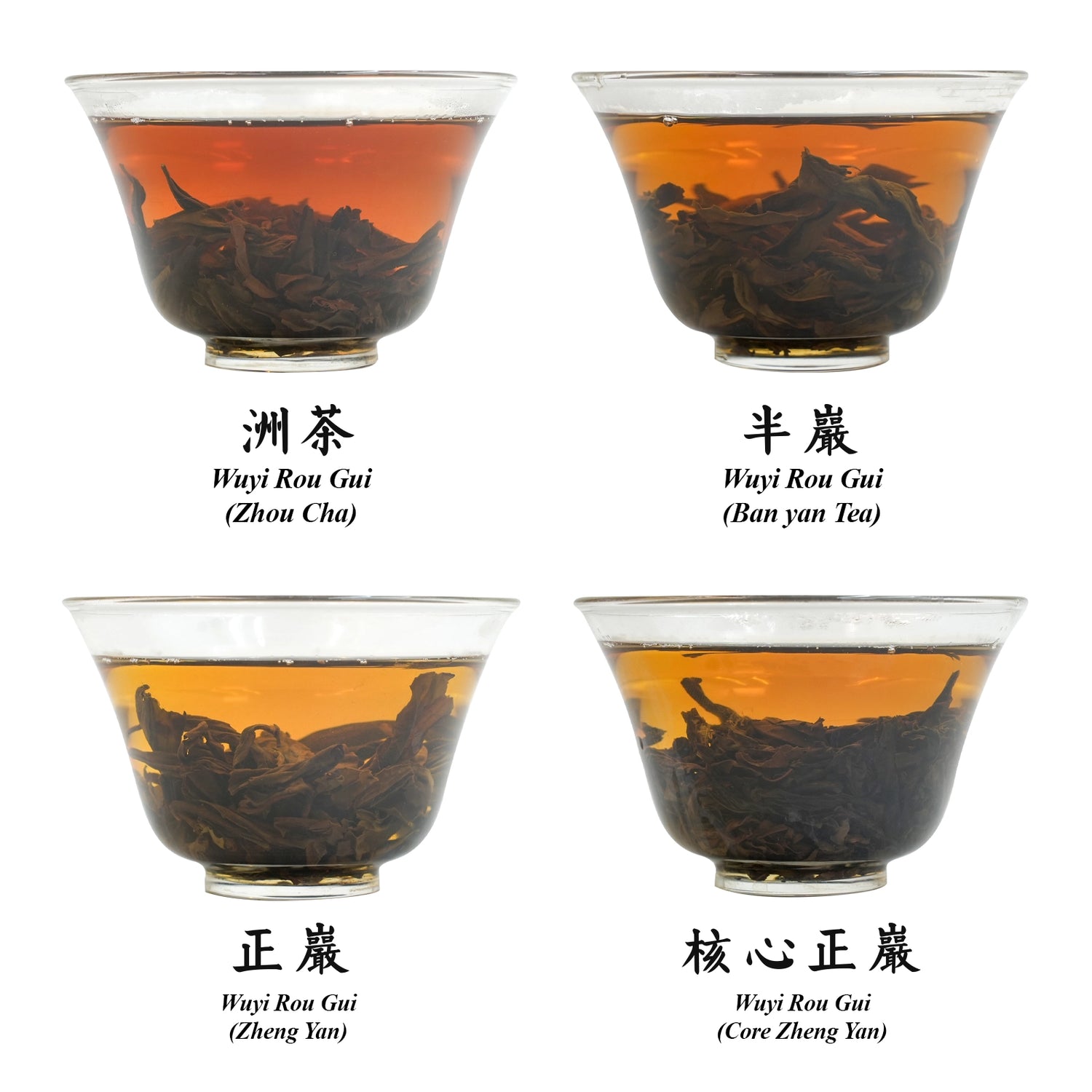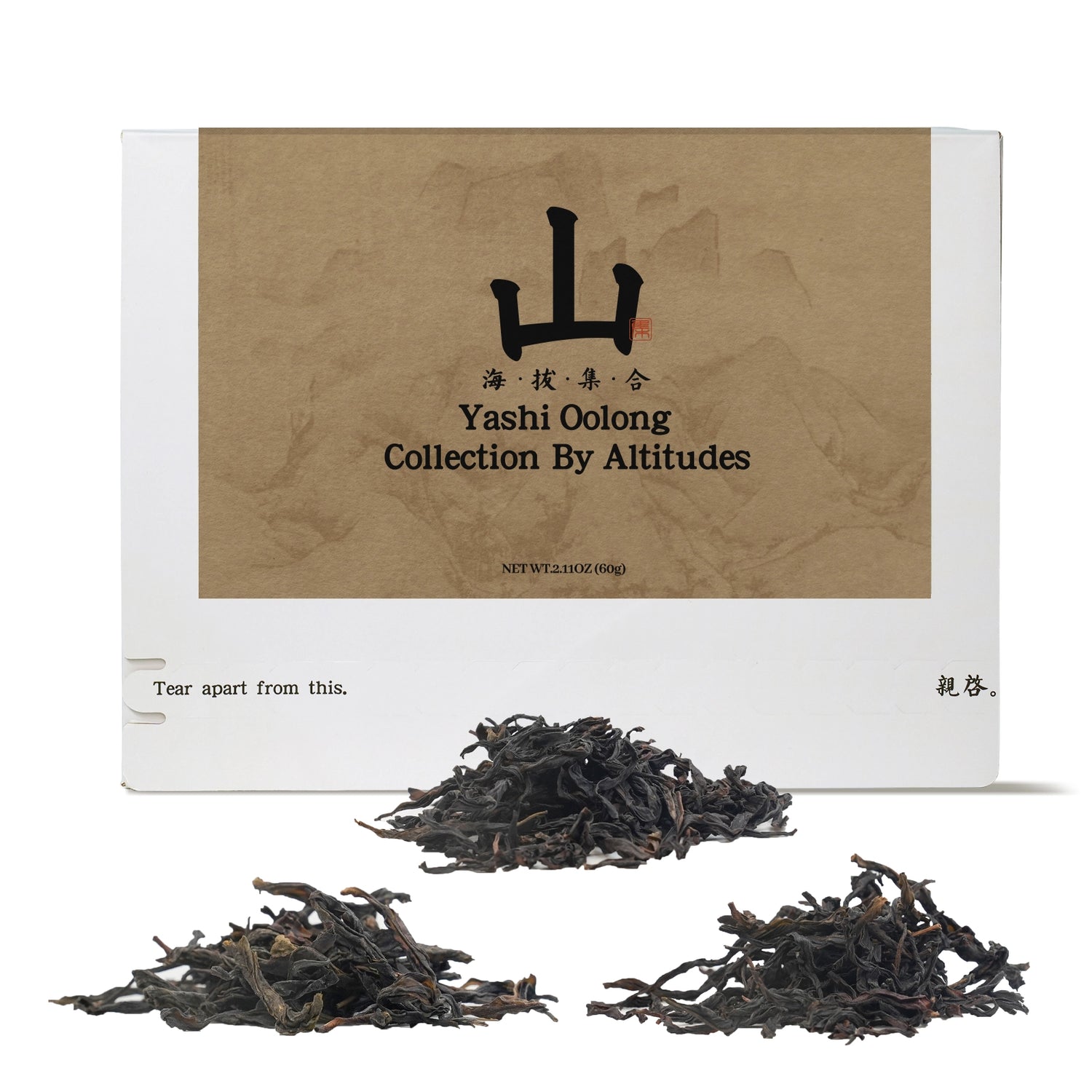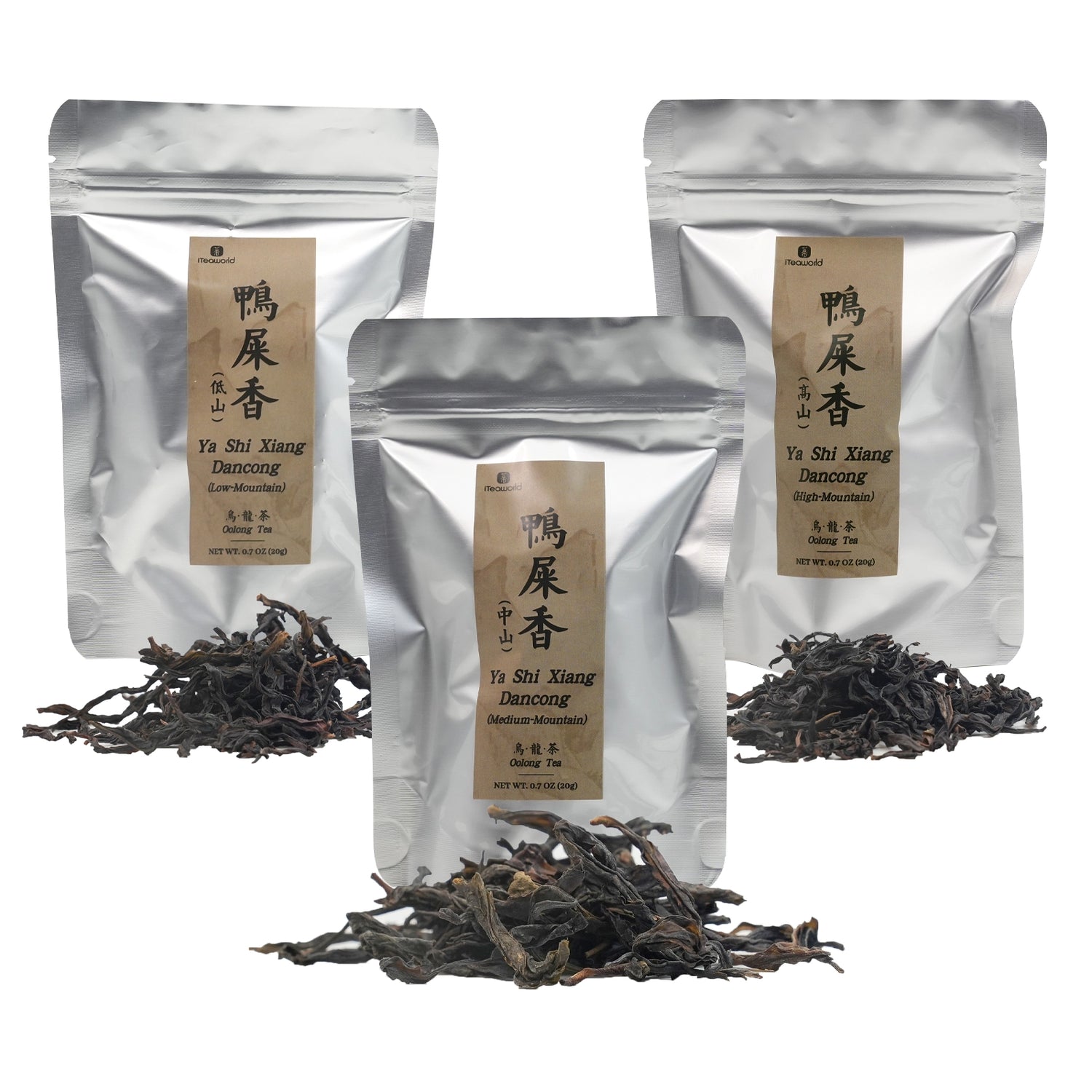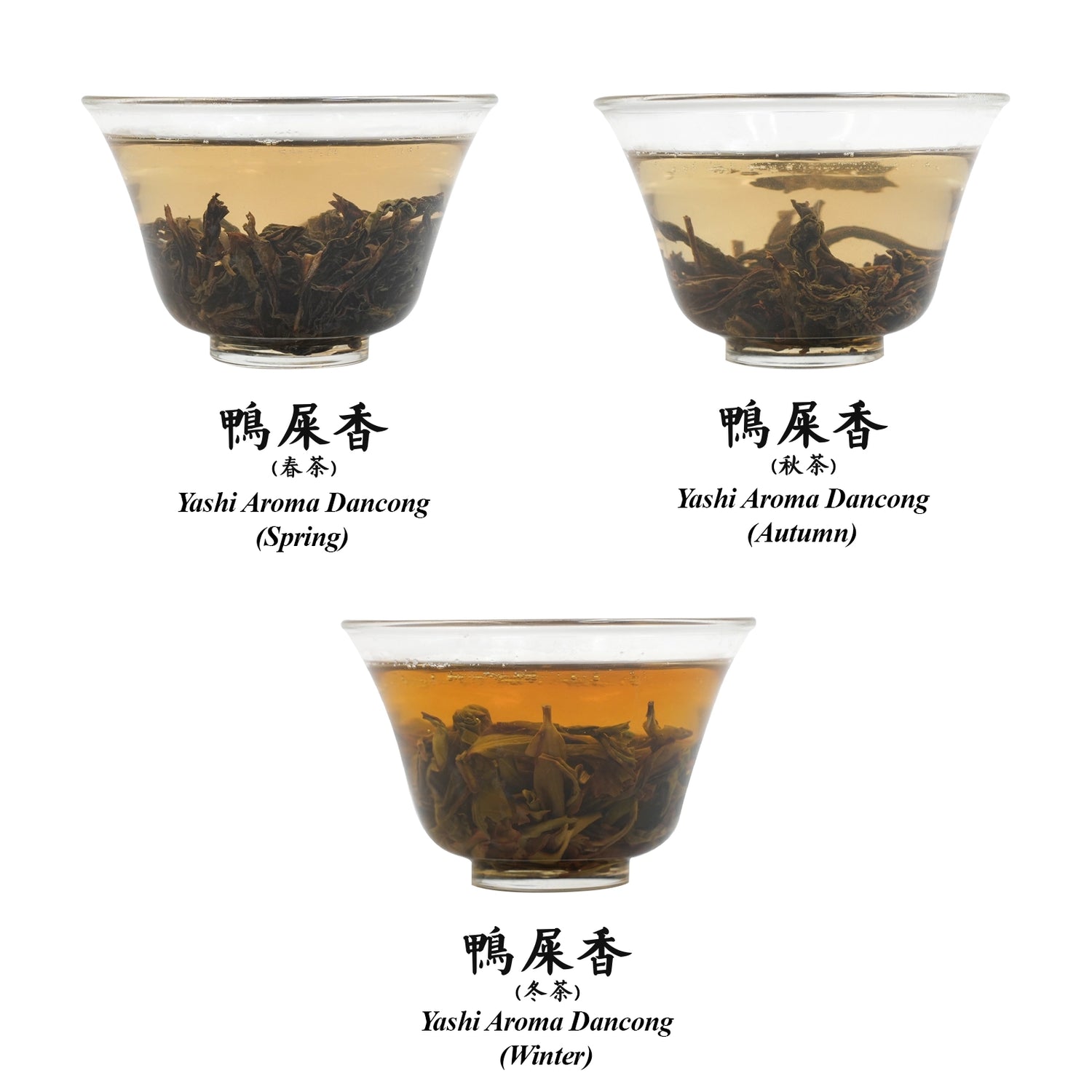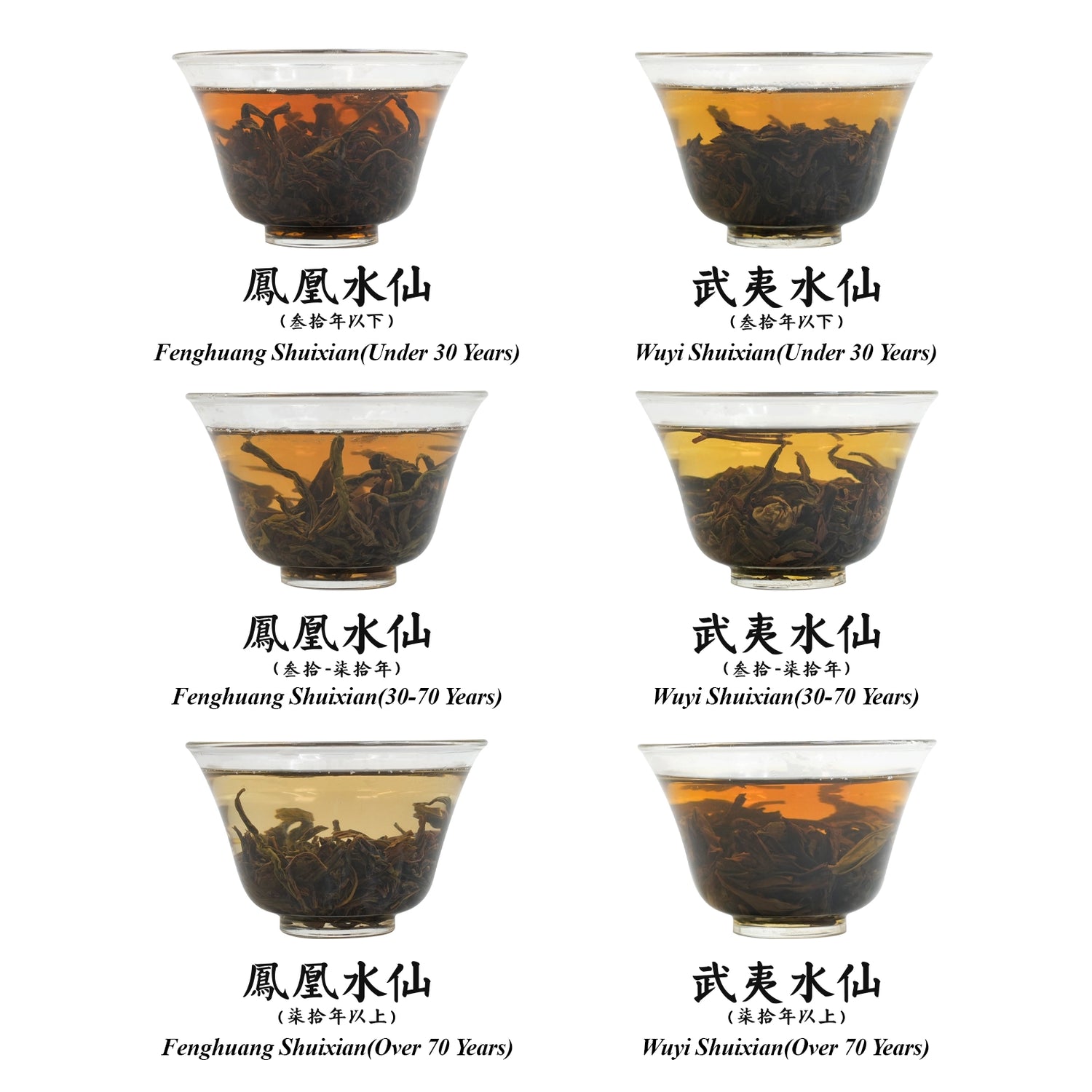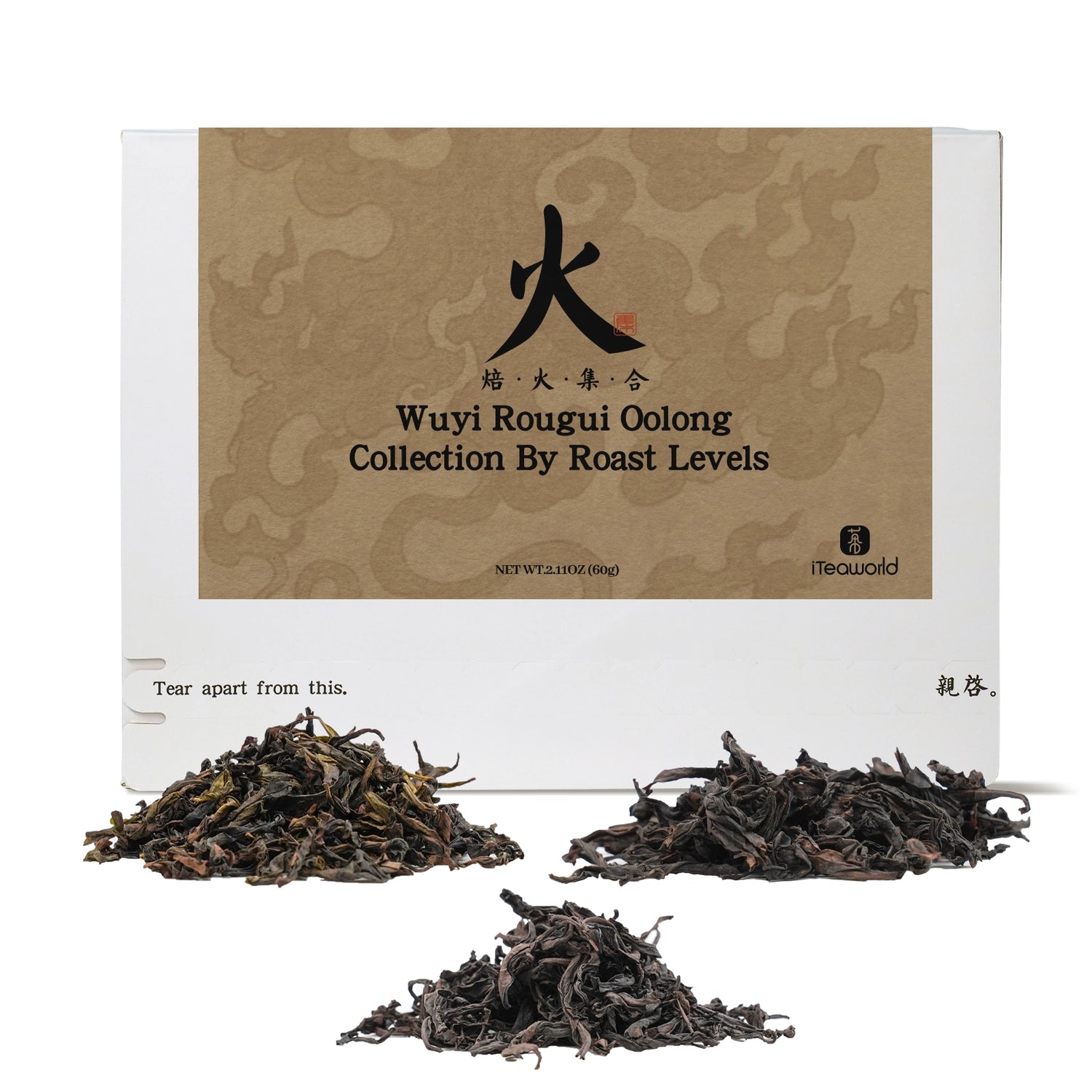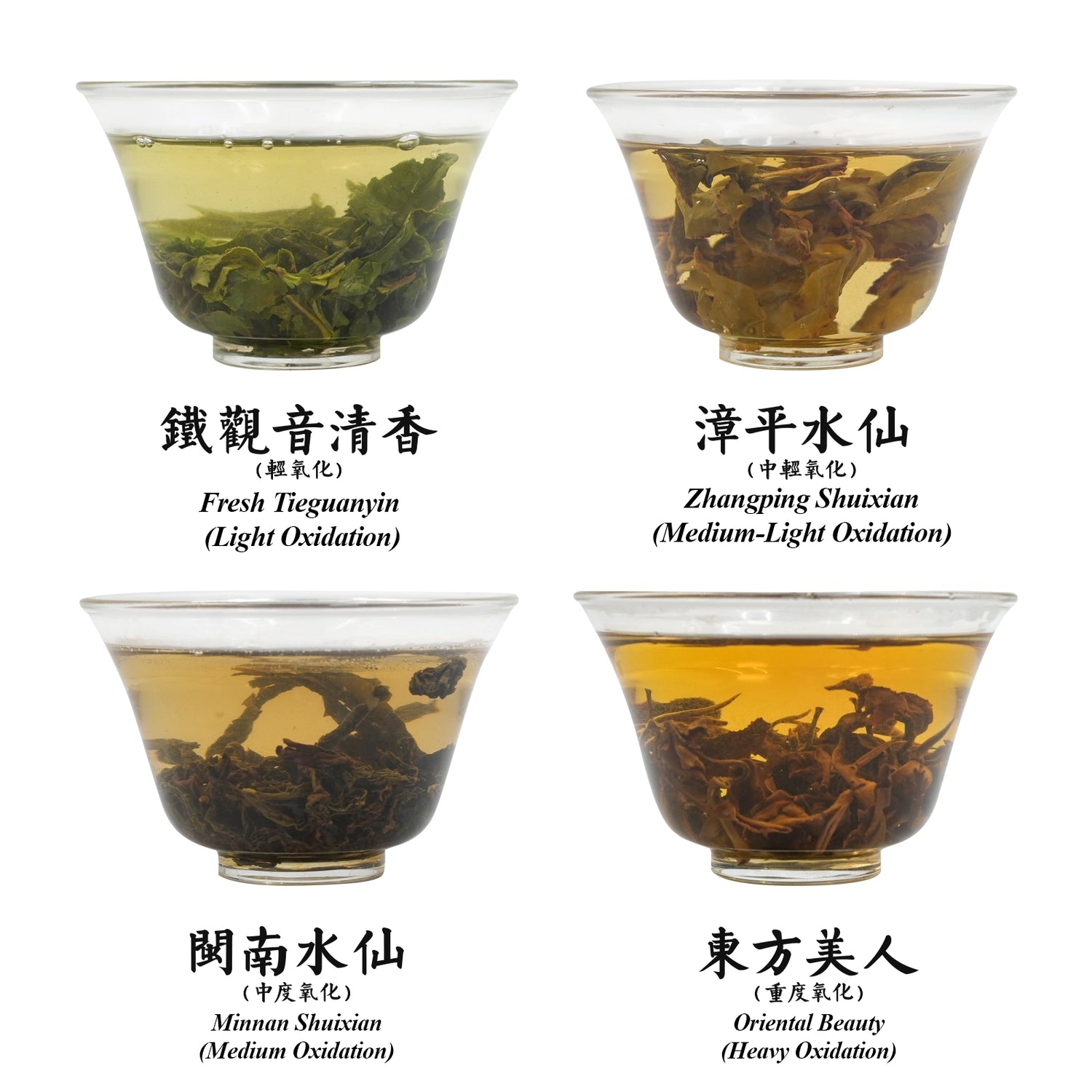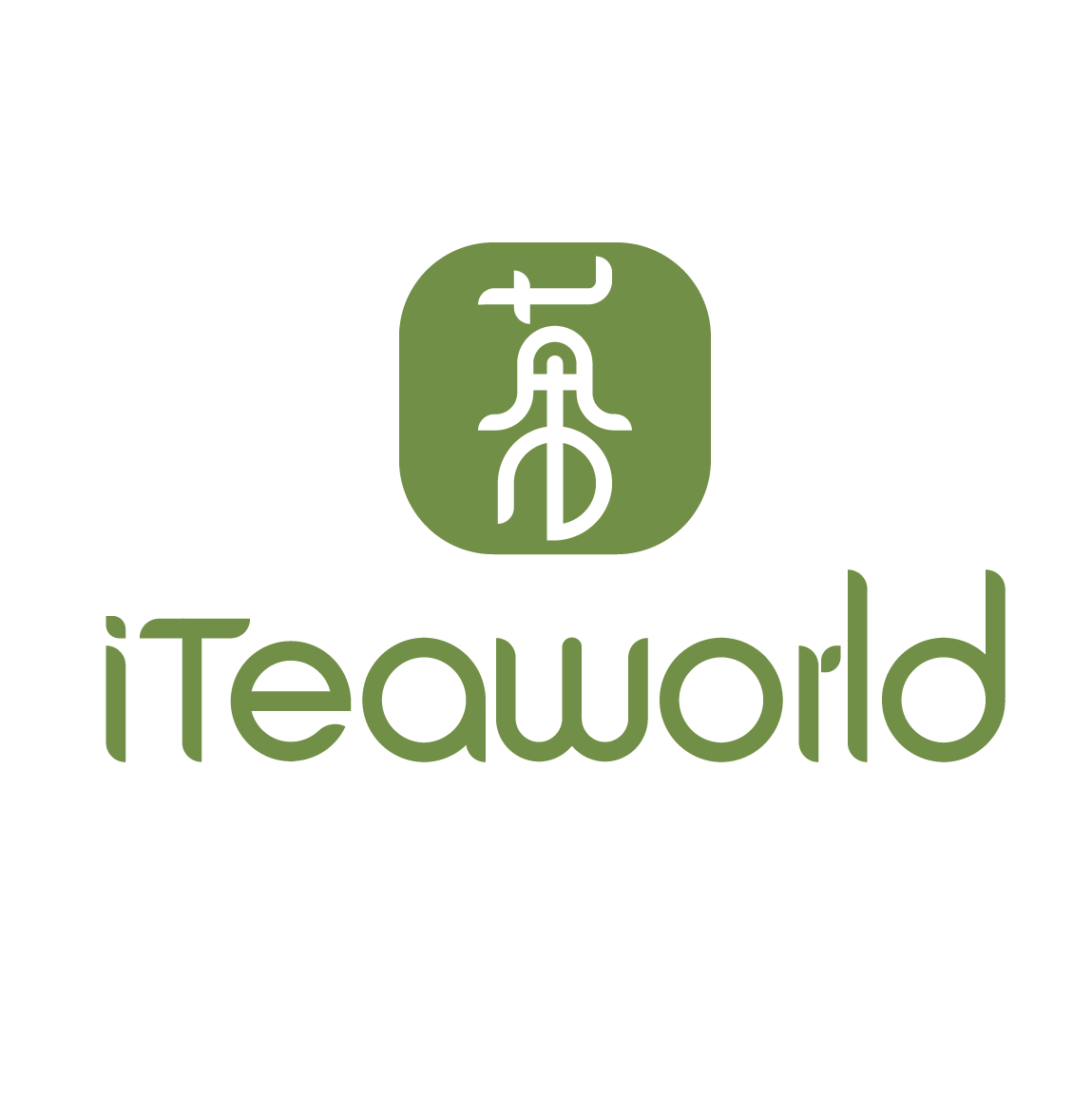6 products
6 products
Sort by:
Soil Environment
In The Classic of Tea by Lu Yu, it’s mentioned that tea trees grow best in different types of soils: “the best grow in rotten rocks, the middle in gravelly soil, and the worst in yellow earth.” Soil with rocks provides good drainage and airflow, preventing both waterlogging in heavy rain and dryness during droughts. It’s rich in minerals, and tea trees thrive in soil that’s both moist and acidic. For example, the finest Wuyi rock teas grow in soil made up of rotten rocks and gravel. On the other hand, lower-grade Wuyi teas, which mainly grow in yellow earth, lack the signature rocky flavor and have simpler, less complex aromas and tastes.
If you want to experience how different soil types affect the flavor of oolong tea, the best example would be a collection of Wuyi Rock Teas from various environments. This includes:
Core Zhengyan Wuyi Tea: Known for its rocky, gravelly soil, represented by the famous Three Pits and Two Streams (San Keng Liang Jian).
Wuyi Zhengyan Tea: Grown in soils rich in sandy gravel rocks.
Wuyi Ban Yan Tea: Grown in thicker layers of rocky red soil.
Wuyi Zhou Tea: Grown in soils dominated by loess (yellow earth).
Products Included:
- Core Zhengyan Wuyi Tea(Core Zheng Yan)20g
- Wuyi Rou Gui (Zheng Yan) 20g
- Wuyi Rou Gui (Ban yan Tea) 20g
- Wuyi Rou Gui (Zhou Cha) 20g
Origin:
- Core Zheng Yan:Wuyuan Jian, Tianxin Village, Wuyi Town, Wuyishan City, Fujian Province
- Zheng Yan:Tianxin Village, Wuyi Town, Wuyishan City, Fujian Province
- Ban yan Tea:Jingshui Village, Xingcun Town, Wuyishan City, Fujian Province, China
- Zhou Cha:Xingtian Town, Wuyishan City, Fujian Province, China
Master Blender:
- Chen Hui
Processing Time:
- October 2024
Best Before Date:
- 36 months
Tea Variety:
- Wuyi Cinnamon Varieties
Altitude:
- Core Zheng Yan:342 meters
- Zheng Yan:400-500 meters
- Ban yan Tea:about 400 meters
- Zhou Cha: about 200 meters
Soil Type:
- Core Zheng Yan:Gravel Soil
- Zheng Yan:sandy gravelly soil
- Ban yan Tea:red soil dominated by thickly bedded rock
- Zhou Cha: yellow soil
Oxidation Level:Medium oxidation (45-55%)
Roasting Level:
- Core Zheng Yan:Three roasts, heavy fire, 105-110°C (221-230°F)
- Zheng Yan:Three roasts, heavy fire, 105-110°C (221-230°F)
- Ban yan Tea:Three roasts, heavy fire, 105-110°C (221-230°F)
- Zhou Cha: Two roasts, medium-heavy fire, around 115°C (239°F)
Roasting Method (Charcoal or Electric):
- charcoal briquetting
Brewing Recommendations:
Chinese-Style Oolong Brewing
Teaware: Gaiwan or clay teapot
Water Temp: 212°F (100°C)
Tea-to-Water Ratio: 1g per 0.7 oz (20ml)
Steep Time: 15 sec (1-3 steeps), add 5-10 sec after
Re-Steep: Up to 7 times
Western-Style Oolong Brewing
Teaware: Teapot, infuser, or French press
Water Temp: 212°F (100°C)
Tea-to-Water Ratio: 1 tsp (2-3g) per 8 oz (240ml)
Steep Time: 3 minutes
Re-Steep: 3 times, adding 1 minutes each time
Should You Really Buy High-Altitude Tea? This Product Might Help You Decide
High-altitude tea is grown in regions with big temperature differences between day and night, cooler temperatures, and frequent cloud cover. These conditions slow down the tea’s growth, keeping the leaves tender and rich in amino acids. This results in teas that are naturally sweeter, fresher, and more aromatic. High-altitude teas are perfect for light to medium oxidation and roasting levels. Examples of high-altitude oolongs include Taiwan High Mountain Tea and Phoenix Dan Cong.
Low-altitude teas, on the other hand, generally have higher levels of tea polyphenols, but tend to have a weaker aroma and lower endurance for multiple infusions.
This product features three Duck Shit Oolong teas, all crafted by the same tea master in Fenghuang Town with similar oxidation and roasting levels. The only difference is the altitude where they were grown, making it easy to compare how altitude affects the tea's flavor.
Products Included:
- Ya Shi Xiang (Duck Shit) Dan Cong Oolong (Low-Mountain) 20g
- Ya Shi Xiang (Duck Shit) Dan Cong Oolong (Medium-Mountain) 20g
- Ya Shi Xiang (Duck Shit) Dan Cong Oolong (High-Mountain) 20g
Origin:
- Lower Hill:Hutou Village, Fenghuang Town, Chaozhou City, Guangdong Province, China
- Middle Mountain:Fengxi Reservoir, Fenghuang Town, Chaozhou City, Guangdong Province, China
- High Mountain:Dongjiao Village,Fenghuang Town,Chaoan District,Chaozhou City,Guangdong Province,China
Master Blender:Lin zhiqiang
Processing Time:June 2023
Best Before Date:36 months
Tea Variety:Ya Shi Xiang variety
Altitude:
- Low-Mountain:300-400 meters
- Medium-Mountain:600 meters
- High-Mountain:800-900 meters
Soil Type: yellow soil
Oxidation Level:30-40%
Roasting Level:
- Low-Mountain:Two roasts, medium-light fire (95-105°C / 203-221°F)
1st roast: June-July 2023,2nd roast: After Mid-Autumn Festival 2023 - Medium-Mountain:Two roasts, medium-light fire (95-105°C / 203-221°F)
- High-Mountain: Three roasts, medium-light fire (95-105°C / 203-221°F),1st roast: June-July 2022,2nd roast: After Mid-Autumn Festival 2022,3rd roast: After Chinese New Year 2023
Roasting Method (Charcoal or Electric):charcoal briquetting
Brewing Recommendations:
Chinese-Style Oolong Brewing
Teaware: Gaiwan or clay teapot
Water Temp: 212°F (100°C)
Tea-to-Water Ratio: 1g per 0.7 oz (20ml)
Steep Time: 10-15 sec (1-3 steeps), add 5-10 sec after
Re-Steep: Up to 7 times
Western-Style Oolong Brewing
Teaware: Teapot, infuser, or French press
Water Temp: 190-200°F (88-93°C)
Tea-to-Water Ratio: 1 tsp (2-3g) per 8 oz (240ml)
Steep Time: 3-5 minutes
Re-Steep: Up to 3 times, adding 1-2 minutes each time
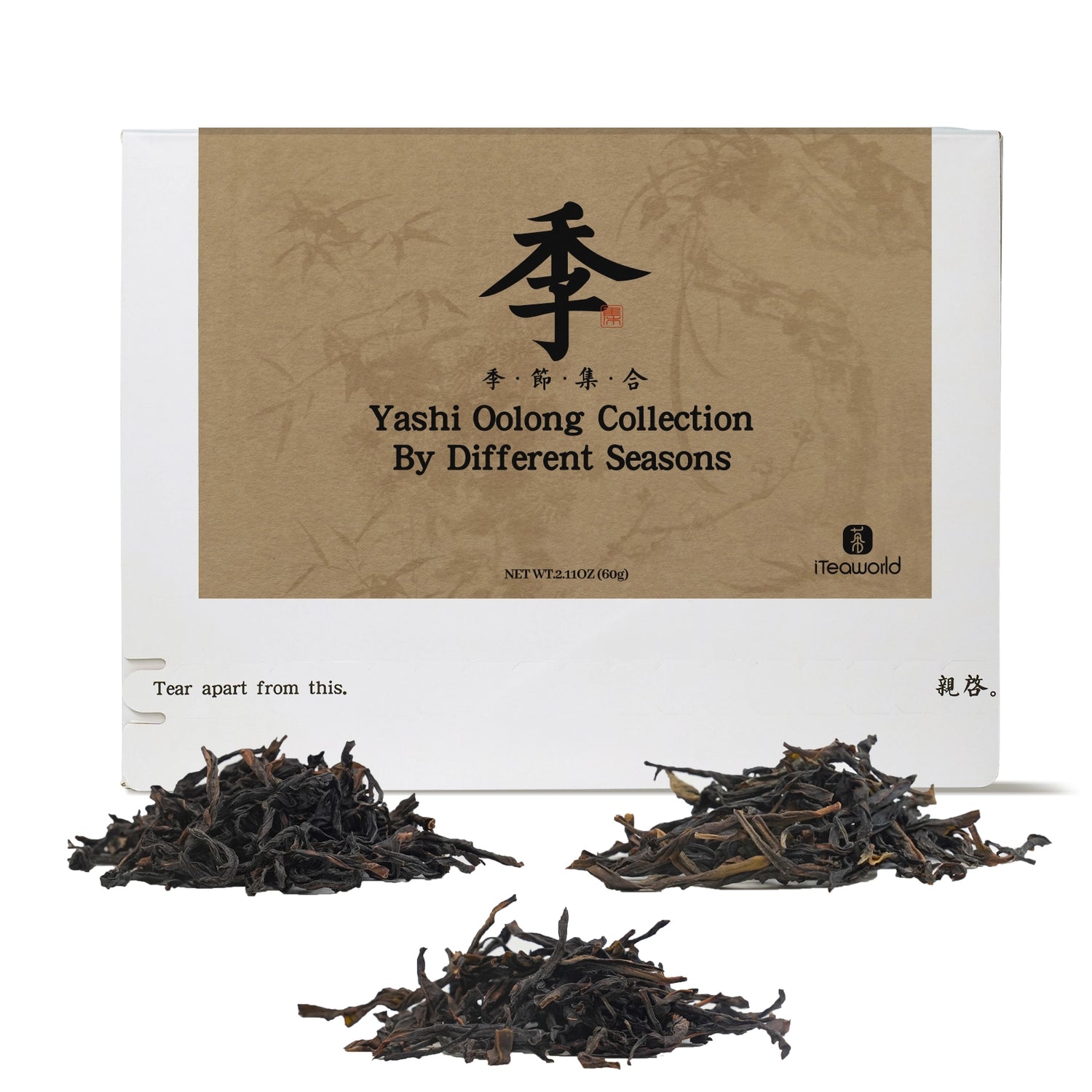
Ya Shi Xiang oolong Comparison Set – Spring, Autumn & Winter Varieties 60g
$19.99
Unit price perYa Shi Xiang oolong Comparison Set – Spring, Autumn & Winter Varieties 60g
$19.99
Unit price perSeasonality of Oolong Tea
Oolong tea can be harvested in all four seasons: spring, summer, autumn, and winter. However, Wuyi rock tea is only harvested in the spring. Oolong teas picked in the midday usually have the most pronounced aroma. Summer teas are mostly used in milk tea and are less common in loose leaf tea markets.
Spring teas tend to grow slower, resulting in higher levels of amino acids and tea polyphenols, with a lower ratio of phenols to amino acids. However, due to the frequent rainy weather in tea-growing areas like Fujian and Guangdong, spring teas may have less aromatic compounds than autumn or winter teas. Therefore, autumn and winter oolongs tend to have a stronger aroma. Winter oolongs, in particular, may even have a crisp, cold-like fragrance. Spring oolongs, on the other hand, tend to be richer in substances, offering a sweeter and fresher taste.
This product features three different seasonal Duck Shit Aroma teas from the same tea master in Hutou Village, Fenghuang Town. The oxidation and roasting levels are different for each, as oolong tea is all about adjusting to the leaves' conditions. Winter leaves are thinner, so oxidation and roasting are usually lighter. Try these three teas to see if you can notice the flavor differences between the seasons.
Products Included:
- Ya Shi Xiang (Duck Shit) Dan Cong Oolong(Spring) 20g
- Ya Shi Xiang (Duck Shit) Dan Cong Oolong(Autumn) 20g
- Ya Shi Xiang (Duck Shit) Dan Cong Oolong(Winter) 20g
Origin:
- Hutou Village, Fenghuang Town, Chaoan District, Chaozhou City, Guangdong Province, China
Master Blender:
- Lin Shupeng
Processing Time:
- November 20, 2024
Best Before Date:
- 36months
Tea Variety:
- Ya Shi Xiang (Duck Shit) Dan Cong variety
Altitude:
- 300-400 meters
Soil Type:
- yellow soil
Oxidation Level:
- Medium oxidation (40-50%)
Roasting Level:
- Spring: Two roasts, medium fire, around 100°C (212°F)
Autumn: Two roasts, medium fire, around 100°C (212°F)
Winter: One roast, light fire, around 80°C (176°F)Very light roast, 70-80°C (158-176°F)
Roasting Method (Charcoal or Electric):
- charcoal briquetting
Brewing Recommendations:
Chinese-Style Oolong Brewing
- Teaware: Gaiwan or clay teapot
- Water Temp: 212°F (100°C)
- Tea-to-Water Ratio: 1g per 0.7 oz (20ml)
- Steep Time: 15 sec (1-3 steeps), add 5-10 sec after
- Re-Steep: Up to 7 times
Western-Style Oolong Brewing
- Teaware: Teapot, infuser, or French press
- Water Temp: 212°F (100°C)
- Tea-to-Water Ratio: 1 tsp (2-3g) per 8 oz (240ml)
- Steep Time: 3-5 minutes
- Re-Steep: Up to 3 times, adding 1minutes each time
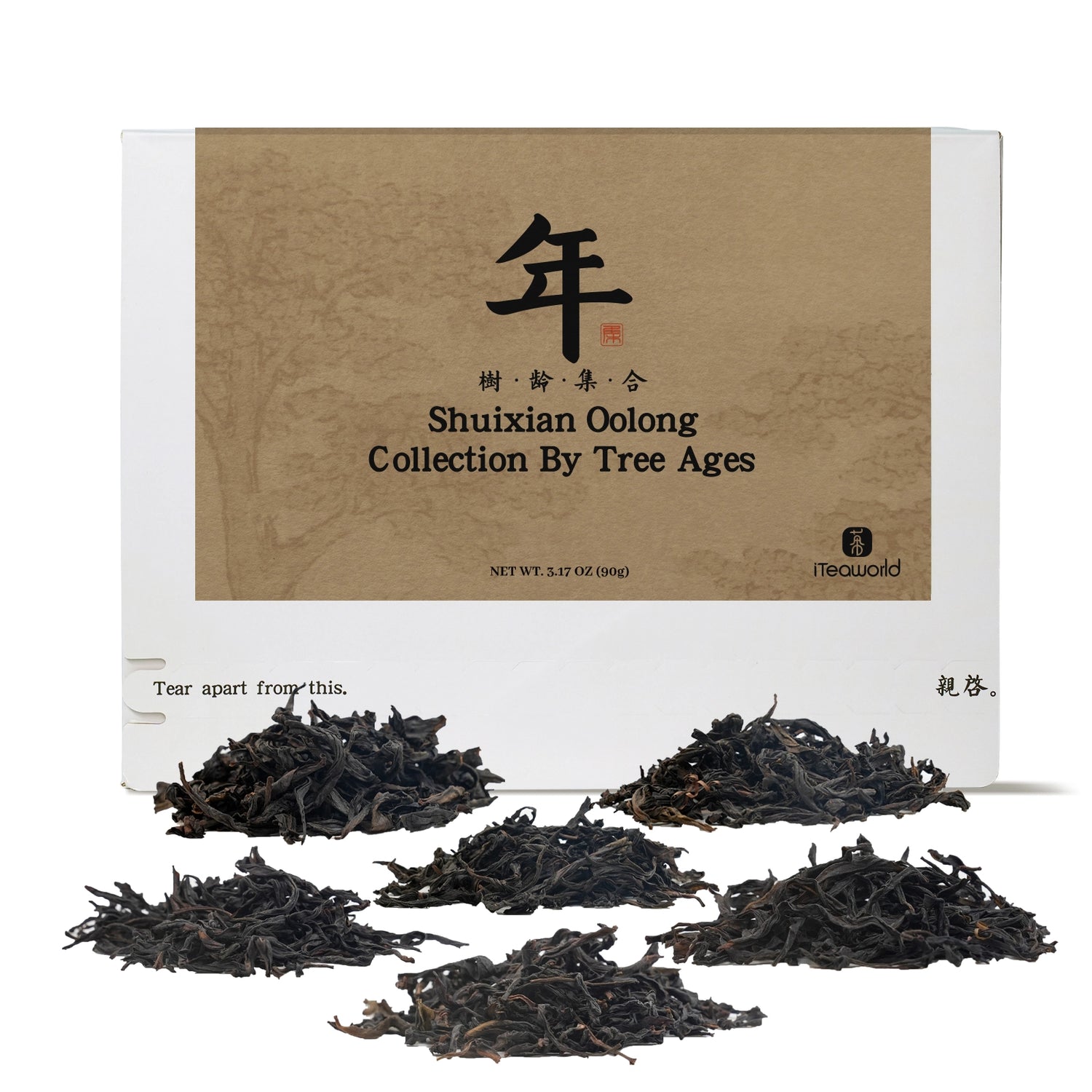
Chinese Oolong Tea Comparison Set: 6 Tree-Aged Blends (Fenghuang & Wuyi Shui Xian)90g
$59.99
Unit price perChinese Oolong Tea Comparison Set: 6 Tree-Aged Blends (Fenghuang & Wuyi Shui Xian)90g
$59.99
Unit price perMaybe You’re Not a Fan of Aged Tea Trees
In both Pu-erh and oolong tea, the age of the tea tree matters. Generally, older trees are rarer, which drives up their price. The age of the trees is most significant in certain oolong varieties, like Shui Xian (including Phoenix Shui Xian, Wuyi Shui Xian, and Minbei Shui Xian).
Typically, younger tea trees contain higher levels of amino acids but lower levels of tea polyphenols and minerals. This results in teas that are sweeter and fresher, but with a lighter, less complex flavor. These teas tend to have more floral notes and are best suited for light fermentation and roasting processes.
On the other hand, older tea trees tend to have higher levels of tea polyphenols, fiber, sugars, and minerals. They’re not as restricted by processing techniques, and the resulting teas are often richer, with more prominent sweetness, a longer-lasting aftertaste, and better endurance for multiple infusions.
This product features Phoenix Shui Xian and Wuyi Shui Xian from the same origin, made with similar processes but from different-aged trees. It’s a great way to compare how tree age influences the flavor of oolong tea.
Products Included:
- Fenghuang Shuixian(Under 30 Years)
- Fenghuang Shuixian(30-70 Years)
- Fenghuang Shuixian(Over 70 Years)
- Wuyi Shuixian (Under 30 Years)
- Wuyi Shuixian (30-70 Years)
- Wuyi Shuixian (Over 70 Years)
Origin:
- Fenghuang Shuixian(Under 30 Years):Shenming Village, Fenghuang Town, Chaoan District, Chaozhou City, Guangdong Province, China
- Fenghuang Shuixian(30-70 Years):Daping Village, Fenghuang Town, Chaoan District, Chaozhou City, Guangdong Province, China
- Fenghuang Shuixian(Over 70 Years):Gezaiwei, Wudong Village, Fenghuang Town, Chaoan District, Chaozhou City, Guangdong Province, China.
- Wuyi Shuixian (Under 30 Years):Jingshui Village, Xingcun Town, Wuyishan City, Fujian Province, China
- Wuyi Shuixian (30-70 Years):Daan Village, Yangzhuang Township, Wuyishan City, Fujian Province
- Wuyi Shuixian (Over 70 Years):Tianxin Village, Wuyi Township, Wuyishan City, Fujian Province
Master Blender:
- Fenghuang Shuixian:Lin Jizhong,林纪中
- Wuyi Shuixian:Chen hui,陈辉
Processing Time:
- Fenghuang Shuixian:Early May 2023
- Wuyi Shuixian:May 2024
Best Before Date:
- 36months
Tea Variety:
- Fenghuang Shuixian variety
- Wuyi Shuixiann variety
Altitude:
- Fenghuang Shuixian(Under 30 Years):760 meters
- Fenghuang Shuixian(30-70 Years):800-90 meters
- Fenghuang Shuixian(Over 70 Years):1150 meters
- Wuyi Shuixian (Under 30 Years):400 meters
- Wuyi Shuixian (30-70 Years):800-900 meters
- Wuyi Shuixian (Over 70 Years):500 meters
Soil Type:
- Fenghuang Shuixian:yellow soil
- Wuyi Shuixian:gravelly soil
Oxidation Level:
- Medium oxidation (40-50%)
Roasting Level:
- Under 30 Years (Option 1): Three roasts, medium-heavy fire (110-115°C / 230-239°F)
- 30-70 Years (Option 1): Three roasts, medium-heavy fire (110-115°C / 230-239°F)
- Over 70 Years (Option 1): Three roasts, medium fire (110-115°C / 230-239°F)
- Under 30 Years (Option 2): Two roasts, heavy fire (110-115°C / 230-239°F)
- 30-70 Years (Option 2): Three roasts, light fire (95-105°C / 203-221°F)
- Over 70 Years (Option 2): Light fire, 95-105°C (203-221°F)
- (Light Fire ~ 80°C, Medium Fire ~ 100°C, Heavy Fire ~ 120°C)
Roasting Method (Charcoal or Electric):
- charcoal briquetting
Brewing Recommendations:
Chinese-Style Oolong Brewing
Teaware: Gaiwan or clay teapot
Water Temp: 212°F (100°C)
Tea-to-Water Ratio: 1g per 0.7 oz (20ml)
Steep Time: 10-15 sec (1-3 steeps), add 5-10 sec after
Re-Steep: Up to 7 times
Western-Style Oolong Brewing
Teaware: Teapot, infuser, or French press
Water Temp: 100°C (212°F)
Tea-to-Water Ratio: 1 tsp (2-3g) per 8 oz (240ml)
Steep Time: 3minutes
Re-Steep: 3 times, adding 1minutes each time
The Art of Roasting Oolong Tea
Roasting oolong tea serves three key purposes: reducing moisture, removing any off-flavors, and lowering caffeine content, all while enhancing the tea's aroma and flavor.Teas with different oxidation levels need different roasting levels. Usually, lightly oxidized teas are lightly roasted to enhance their flavor. If a tea is lightly oxidized but heavily roasted, it can taste too smoky, often because the oxidation wasn’t done properly and the roasting is used to cover it up.
The level of roasting significantly impacts the tea’s aroma and taste. Light roasting preserves the fresh, floral fragrance, while heavy roasting creates a richer, smoother brew with toasty or smoky undertones.
This tea features Wuyi Rougui oolong from the renowned Wuyi Mountains in Fujian, crafted by the same tea master. The only difference lies in the roasting level, offering you an excellent opportunity to explore how roasting shapes the flavors of oolong tea.
Origin:Jingshui Village, Xingcun Town, Wuyishan City, Fujian Province, China
Master Blender:Chen Hui
Processing Time:November 2024
Best Before Date:24 months
Tea Variety:Wuyi Cinnamon
Altitude:about 400 meters
Soil Type:gravelly soil
Oxidation Level:Oxidization 45-55%
Roasting Level:Single Roast: Light roast, 90-100°C (194-212°F)
Triple Roast: Medium roast, 105-115°C (221-239°F)
Triple Roast (Full Fire): Heavy roast, 120-130°C (248-266°F)
Roasting Method (Charcoal or Electric):
Light cinnamon: electric roasting 20g
Medium fire cinnamon: charcoal briquetting 20g
Full Flame Cinnamon: charcoal briquetting 20g
Brewing Recommendations:
Chinese-Style Oolong Brewing
Teaware: Gaiwan or clay teapot
Water Temp: 212°F (100°C)
Tea-to-Water Ratio: 1g per 0.7 oz (20ml)
Steep Time: 10-15 sec (1-3 steeps), add 5-10 sec after
Re-Steep: Up to 7 times
Western-Style Oolong Brewing
Teaware: Teapot, infuser, or French press
Water Temp: 190-200°F (88-93°C)
Tea-to-Water Ratio: 1 tsp (2-3g) per 8 oz (240ml)
Steep Time: 3-5 minutes
Re-Steep: Up to 3 times, adding 1-2 minutes each time
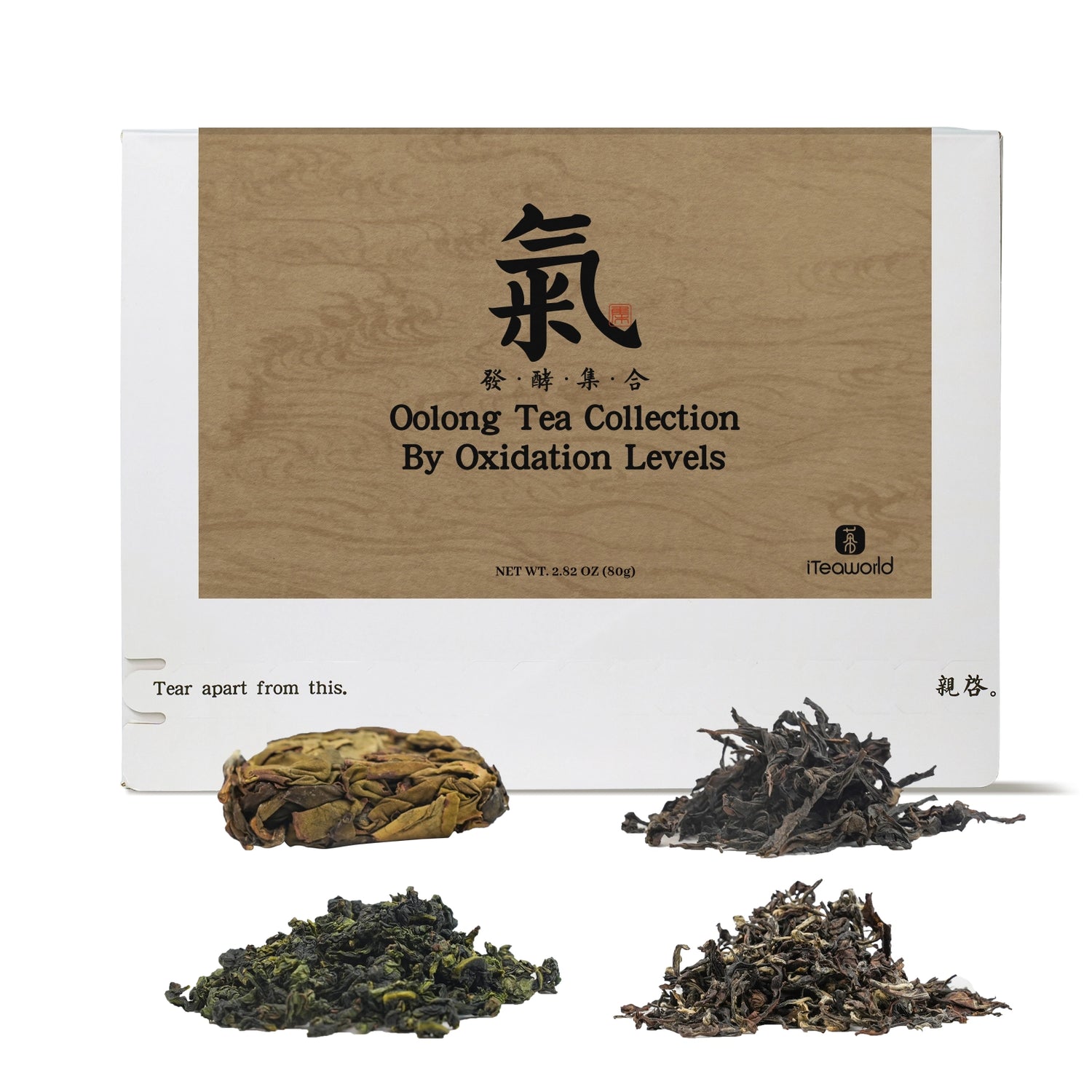
Oolong Tea Comparison Set: 4 Oxidation Levels (Tieguanyin to Oriental Beauty) 80g
$34.99
Unit price perOolong Tea Comparison Set: 4 Oxidation Levels (Tieguanyin to Oriental Beauty) 80g
$34.99
Unit price perOolong Tea: The Balance of Oxidation
Oolong tea is a partially oxidized tea, with oxidation levels ranging from 10% to 70%. Oxidation plays a key role in shaping the tea's aroma and the brightness of its flavor. Light oxidation creates fresh floral and fruity notes, while higher oxidation brings out richer, more mature fruit or honey-like aromas.
Lightly Oxidized Oolong (10%–25%): Examples like Wen Shan Baozhong and light-roast Tieguanyin showcase fresh floral and fruity scents.
Moderately Oxidized Oolong (25%–50%): Teas such as Phoenix Dan Cong and medium-roast Tieguanyin have a balanced profile, combining floral notes with hints of honey, fruit, or roasting, resulting in a complex aroma.
Heavily Oxidized Oolong (50%–70%): Classics like Da Hong Pao, Wuyi Rougui, and Oriental Beauty deliver mature fruit aromas, roasted or caramel-like notes, and a smooth, full-bodied brew.
This product includes four renowned oolong teas, all lightly roasted but with varying oxidation levels. It’s the perfect way to explore how different oxidation levels influence the flavor and aroma of oolong tea.
Products Included:
- Fresh Tieguanyin (Light Oxidation) 20g
- Zhangping Shuixian Oolong Tea (Medium-Light Oxidation) 20g
- Minnan Shuixian (Medium Oxidation) 20g
- Oriental Beauty (Heavy Oxidation) 20g
Origin:
- Fresh Tieguanyin: Longjuan Village, Longjuan Township, Anxi County, Fujian Province, China
- Zhangping Shuixian:Beiliao Village, Nanyang Town, Zhangping City, Fujian Province, China
- Minnan Shuixian:Wuxi Village, Wufeng Town, Yongchun County, Quanzhou City, Fujian Province, China
- Oriental Beauty:Neiyang Village, Pingshan Township, Sanming City, Fujian Province, China
Master Blender:
- Fresh Tieguanyin: Chen Qizhi
- Zhangping Shuixian:He Meiqing
- Minnan Shuixian:Xu Yongyuan
- Oriental Beauty:Li Jianmin
Processing Time:
- Fresh Tieguanyin: November 2024
- Zhangping Shuixian:June 2024
- Minnan Shuixian:December 2024
- Oriental Beauty:early June 2024
Best Before Date:24months
Tea Variety:
- Tieguanyin: Tieguanyin Varieties
- Zhangping Shui Xian: Minnan Shuixian Varieties
- Minnan Shuixian: Jianyang Shui Xian Varieties
- Oriental Beauty: Jin Xuan variety
Altitude:
- Tieguanyin: 800-900 meters
- Zhangping Shui Xian: 400-500 meters
- Minnan Shuixian:900-1000 meters
- Oriental Beauty:1100 meters
Soil Type:
- Tieguanyin: red soil
- Zhangping Shui Xian: yellow and red soil
- Minnan Shuixian: red soil
- Oriental Beauty:Red soil
Oxidation Level:
- Tieguanyin: Light oxidation (10-20%)
- Zhangping Shui Xian: Mild-light oxidation (25-30%)
- Minnan Shuixian: Medium oxidation (40-50%)
- Oriental Beauty:Heavy oxidation (60-70%)
Roasting Level:
- Very light roast, 70-80°C (158-176°F)
Roasting Method (Charcoal or Electric):
- electric roasting
Brewing Recommendations:
Chinese-Style Oolong Brewing
Teaware: Gaiwan or clay teapot
Water Temp: 212°F (100°C)
Tea-to-Water Ratio: 1g per 0.7 oz (20ml)
Steep Time: 10-15 sec (1-3 steeps), add 5-10 sec after
Re-Steep: Up to 7 times
Western-Style Oolong Brewing
Teaware: Teapot, infuser, or French press
Water Temp: 90-100°C (194-212°F)
Tea-to-Water Ratio: 1 tsp (2-3g) per 8 oz (240ml)
Steep Time: 3-5 minutes
Re-Steep: Up to 3 times, adding 1-2 minutes each time


